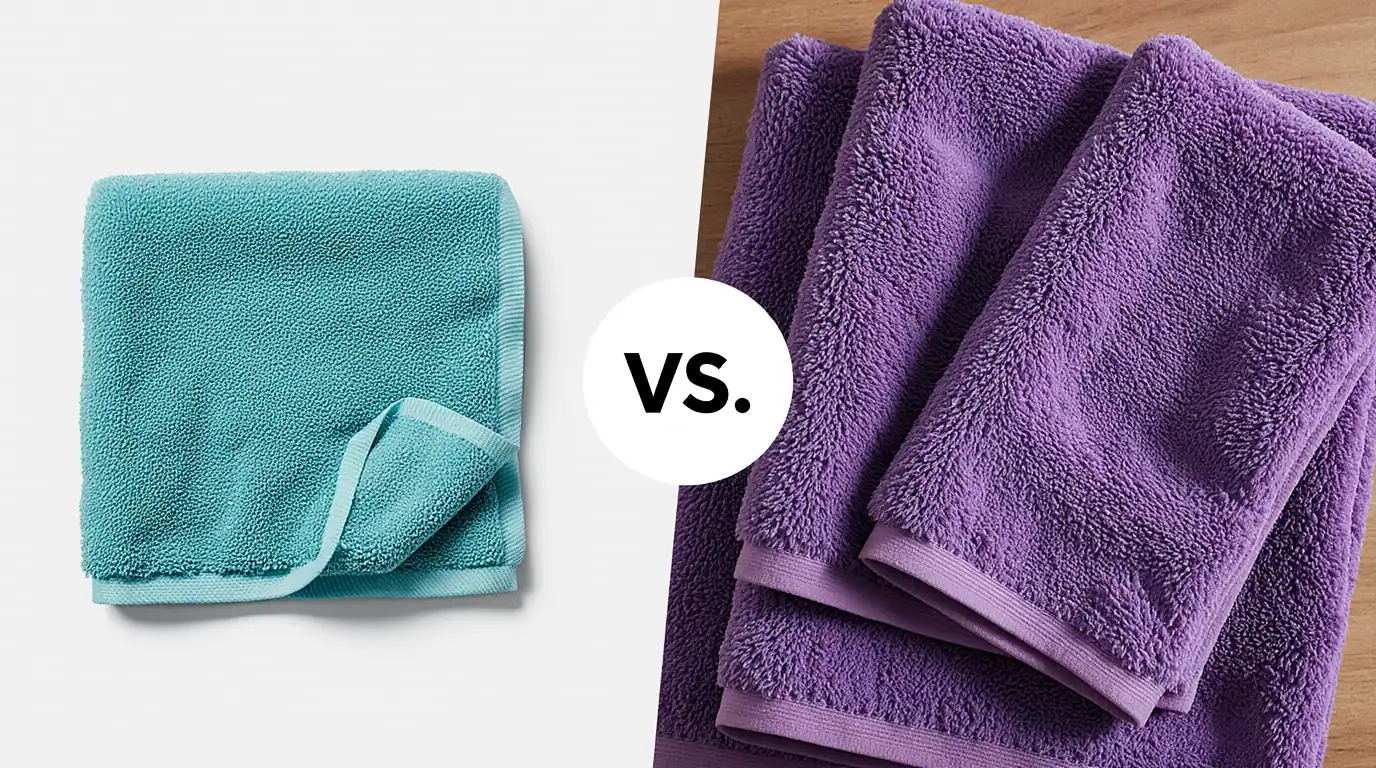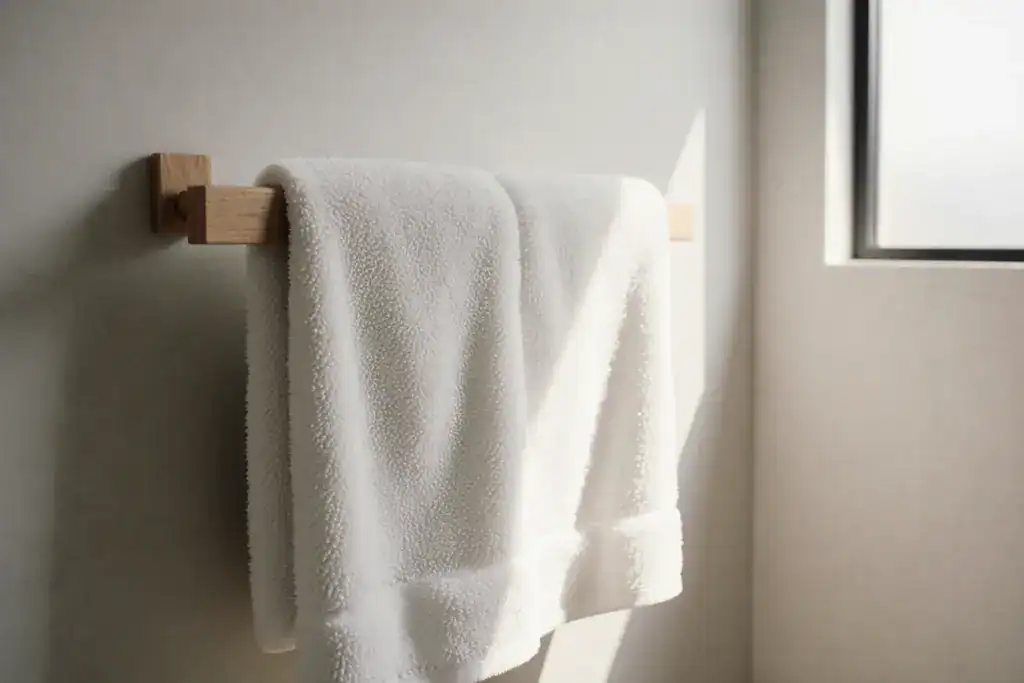In the landscape of bathroom linens, two towels often get confused: the small, trusty washcloth and the ever-present hand towel. While they might hang side-by-side, their roles are worlds apart. You might think grabbing either one will do the job, but using the wrong one isn’t just a minor mix-up; it can impact your skin health, bathroom hygiene, and overall experience.
Understanding the specific functions of a washcloth vs. a hand towel is the key to a cleaner, more efficient, and even luxurious bathroom routine. This comprehensive guide will break down every detail—from size and purpose to materials and proper care—so you can choose with confidence and use each towel exactly as it was intended.
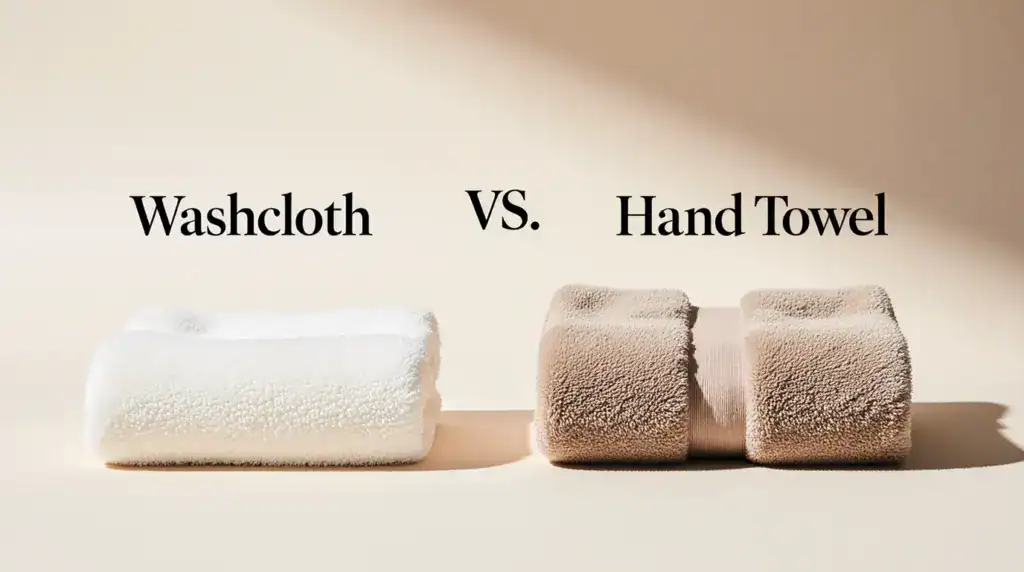
Deep Dive: The Mighty Washcloth
A washcloth is a small, typically square piece of absorbent cloth designed specifically for washing the body and face. Often called a face towel, washrag, or face flannel, it is the smallest member of the bath towel family.
Common Size
Washcloths are easy to spot due to their compact size, with standard dimensions being 12×12 inches or 13×13 inches. This manageable size makes them perfect for navigating the sensitive areas of your face, like around the eyes and nose.
Primary Purpose: Cleansing and Exfoliation
The main point of using a washcloth is to provide physical exfoliation while you cleanse. Its textured surface is more effective than hands alone at scrubbing away dirt, oil, makeup, and dead skin cells. This deep-cleansing action helps clear pores, stimulates circulation for a healthier glow, and can lead to smoother skin. It also helps your soap or cleanser work up a richer lather. Its uses include:
- Washing the face and body.
- Effectively removing makeup, oil, and dirt.
- Providing gentle daily exfoliation to slough off dead skin cells.
- Being perfect for the delicate skin of babies and children.
Choosing Your Material
Washcloths come in a variety of materials, each suited for different needs.
- Cotton Terry: This is the classic choice, with a looped pile that is great for a gentle scrub and exfoliation.
- 100% Cotton/Organic Cotton: Ideal for people with sensitive skin, including infants, this material is soft and gentle.
- Microfiber/Polyester: These materials are excellent at grabbing and removing makeup, oils, and dirt with minimal product.
- Bamboo: Known for its silky softness and natural antibacterial properties, bamboo is a great option for sensitive or acne-prone skin.
- Turkish Cotton: For a washcloth that is exceptionally soft, fluffy, and absorbent.
Deep Dive: The Essential Hand Towel
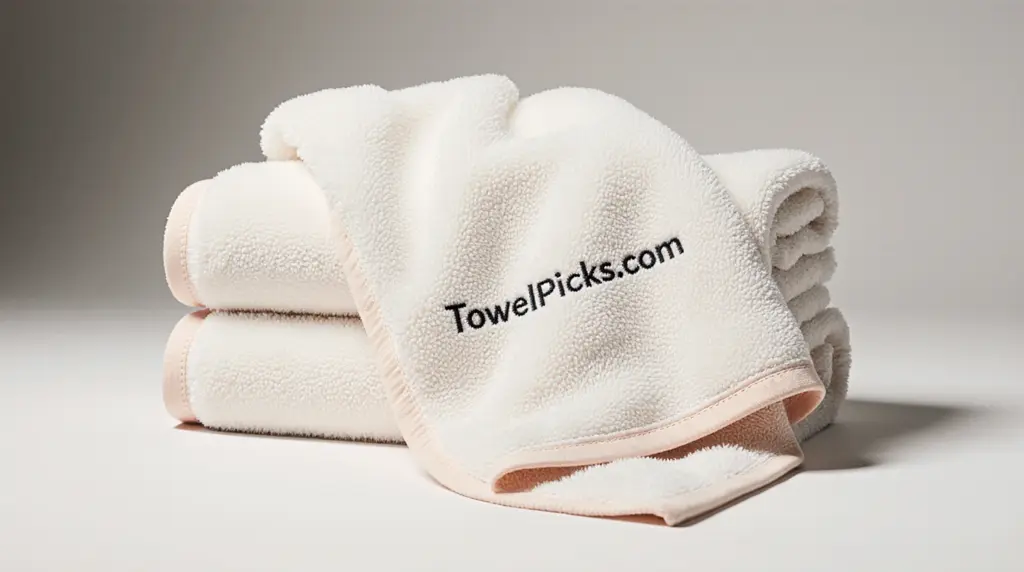
A hand towel is a multi-purpose rectangular towel that is larger than a washcloth but smaller than a bath towel, intended primarily for drying.
Common Size
Standard hand towel dimensions are typically around 16×28 inches, 16×30 inches, or 18×30 inches. This larger surface area is designed to handle multiple hand dryings before becoming saturated.
Primary Purpose: Drying
The hand towel’s main job is drying hands after washing. You’ll find it as a fixture on a towel ring or rack next to any bathroom or kitchen sink. It can also be used for secondary tasks like drying your hair or as a decorative accent in a guest bathroom.
Understanding Quality: GSM Explained
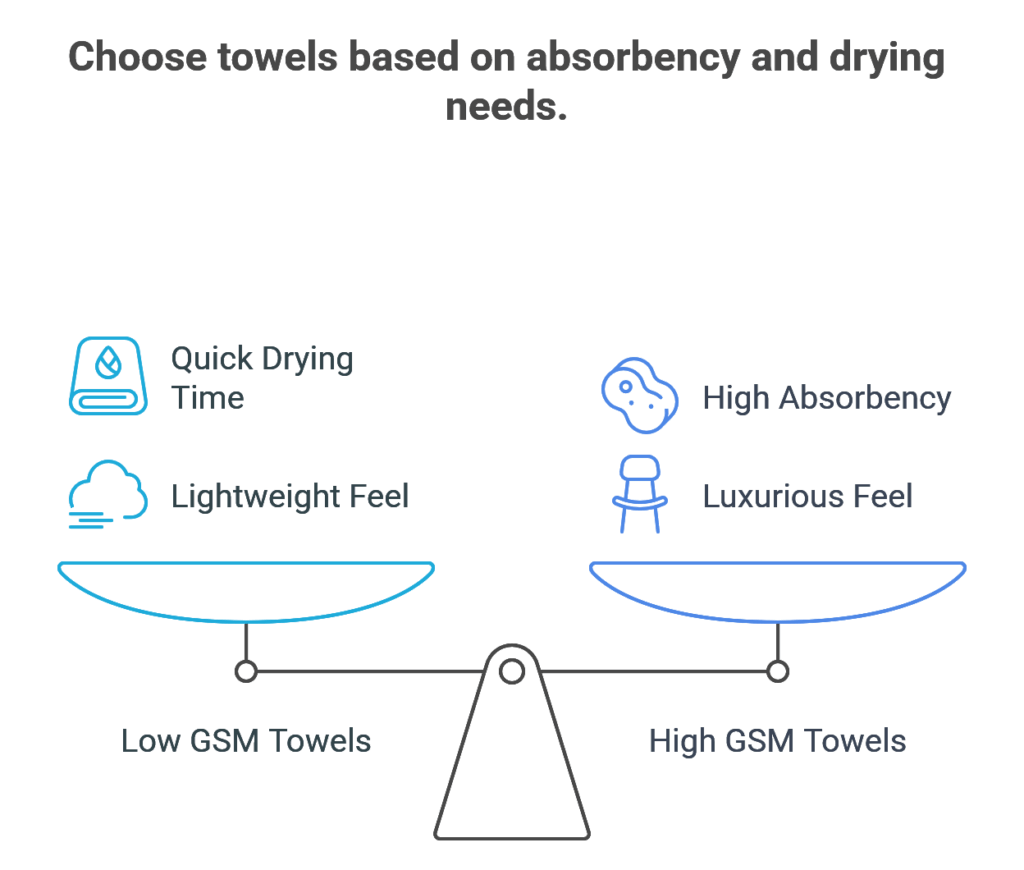
When purchasing a hand towel, it’s important to look for materials that are highly absorbent. A key measure of a towel’s quality is its GSM (Grams per Square Meter), which indicates its density and weight.
- Low GSM (300-400): These towels are lighter, thinner, and dry more quickly, making them suitable for the gym or kitchen.
- Medium GSM (400-600): This range offers the perfect balance of absorbency, softness, and drying time for everyday hand towels. Washcloths also often fall in this range.
- High GSM (600-900): Extremely plush, absorbent, and luxurious, these towels provide a premium feel but take longer to dry. Hand towels designed for absorbency often have a higher GSM.
- Ideal Materials: For hand towels that need to be both durable and soft, look for robust materials like 100% Cotton, Terry Cloth, and Long-staple or Combed Cotton.
Solving the Confusion: What About a “Face Towel?”
The term “face towel” often adds to the confusion, as it can mean two different things.
- A Synonym for a Washcloth: In many regions, particularly the U.S., the terms “face towel” and “washcloth” are used interchangeably to refer to the small, square towel used for cleansing.
- A Dedicated Drying Towel: For skincare aficionados, a “face towel” is a separate, ultra-soft towel used only for patting the face dry after washing. This practice prevents transferring bacteria from a multi-use hand towel onto freshly cleaned skin. These dedicated face towels are often made from premium, gentle materials like high-quality cotton, microfiber, or bamboo.
Recommendation: Whether you call it a washcloth or a special face towel, using a dedicated, clean towel for your face is a fantastic practice for healthier skin.
At a Glance: Key Differences
This table provides a simple, clear summary for a quick comparison.
| Feature | Washcloth | Hand Towel |
|---|---|---|
| Size | Small & Square (~13×13 in) | Medium & Rectangular (~16×28 in) |
| Purpose | Washing & Cleansing (Face & Body) | Drying (Primarily Hands) |
| Location | In/near the shower, tub, or sink caddy | On a towel rack or ring by the sink |
| Hygiene | Strictly personal use; wash after 1 use. | Can be shared; change every 1-2 days. |
| Texture | Varies from scrubby to silky-soft. | Typically plush and highly absorbent. |
Hygiene is Key: Why You Should Never Mix Them Up
It may seem harmless to grab whatever towel is closest, but mixing up their functions can create hygiene issues. Damp towels are a perfect breeding ground for bacteria, and using the wrong one can transfer unwanted grime and germs.
- Washcloth Contamination: A used washcloth contains oils, dirt, makeup, and dead skin cells from cleansing. Wiping your hands on it simply transfers that grime back onto your clean hands. Using a washcloth on your face after someone else has used it on their body can lead to breakouts and skin irritation.
- Hand Towel Contamination: While your hands are clean when you dry them, the hand towel itself is often shared among family members and guests. Using this towel on your face can introduce bacteria that you just worked so hard to wash off.
Pro-Tip: For optimal hygiene, consider having a separate, distinct set of hand towels for guests to use. This not only makes them feel welcome but also keeps the family towels separate.
The Ultimate Guide to Towel Care
Proper care will keep your towels fresh, soft, and absorbent for years to come.
First Use
Always wash new towels before using them. This initial wash removes finishing chemicals and “opens up” the cotton fibers for maximum absorbency.
Washcloths:
- Because they are used for cleansing and accumulate oils and bacteria, they should be washed after every single use.
- Wash them in hot water to ensure they are properly sanitized.
- Keep a dedicated small hamper or basket in the bathroom for used washcloths to make laundry day easier.
Hand Towels:
- Replace your hand towel with a clean one every 1-2 days. In a high-traffic or humid bathroom, it’s best to change it daily.
- Ensure hand towels hang freely on a rack or ring so they can dry completely between uses to prevent mildew and bacterial growth.
Washing Best Practices:
- Avoid Fabric Softener: While it seems like a good idea, fabric softener leaves a waxy residue that coats towel fibers, destroying their absorbency over time.
- Use White Vinegar: Add about a cup of white vinegar to the rinse cycle every few washes. It naturally strips away residue, kills odors, and softens towels.
- Don’t Overload the Washer: Give towels plenty of room to circulate in the washing machine so they can get thoroughly clean.
- Dry Thoroughly: Make sure towels are completely dry before folding and storing them to prevent musty smells. Tossing in a few wool dryer balls can speed up drying and increase fluffiness.
Conclusion: The Right Towel for the Right Job
Ultimately, the debate of washcloth vs. hand towel is settled by their distinct purposes: washcloths are for washing, and hand towels are for drying. Their differences in size, material, absorbency, and hygiene protocols are all by design to make them the perfect tool for their specific job.
Being mindful of which towel you use is a small change that makes a big impact on your personal hygiene, skincare routine, and the overall health and feel of your bathroom.
Now that you’re a towel expert, it’s time to upgrade your collection. Looking for the perfect exfoliating washcloth or a set of luxurious, quick-drying hand towels? Browse our curated selections at TowelPicks.com to find your perfect match!

